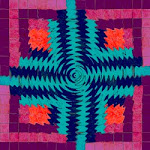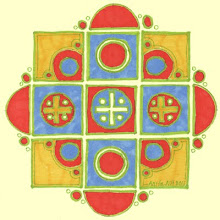
Initially I was excited by
Perfect Square (Yellow) No. 1 pictured above because it was my first application of "Cutout" in Photoshop. You can see how the character of the original drawing was transformed by enlarging the example below:

After discovering how nicely
Perfect Square (Yellow) No.2 reacted when half-brick repeated, I decided that my first version, application of "Cutout" not withstanding, was boring and set out to improve on it. The attempt to retrofit the original design became a lesson in how not to make a successful pattern, and demonstrated how much I still have to learn to become truly proficient in photoshop.
I have since decided that the success of Perfect Square (Yellow) No.2 is due, to a large extent, to its asymmetrical nature. But I made the choice to mess about with No. 1 by attacking it at the center:
Sensing a problem, I carried the project forward by partially obscuring the big misty blue blob in the center and repeated like so:
I was stuck. So I decided to invert the colors in an attempt to achieve novelty. (If you've seen my Spoonflower shop banner you will realize I have traveled this road before! )
At this point I had completely worked myself into the proverbial corner. My one last resort to save the project was to bump up the orange:
The more I consider this exercise of pattern design for fabric, the more I realize how exponentially explosive the possibilities can become. I have a whole
Tumblr full of images to play around with, and I can cull through my
digital collage posts on this site for more inspiration. Plus my collage activities now have a new focus.
 I was blown away this morning by the discovery of these two Vimeo videos about the creation of a logo for More4, the British digital television channel. The design consists of a beautiful and colorful moving array of right isosceles triangles.
I was blown away this morning by the discovery of these two Vimeo videos about the creation of a logo for More4, the British digital television channel. The design consists of a beautiful and colorful moving array of right isosceles triangles.












































